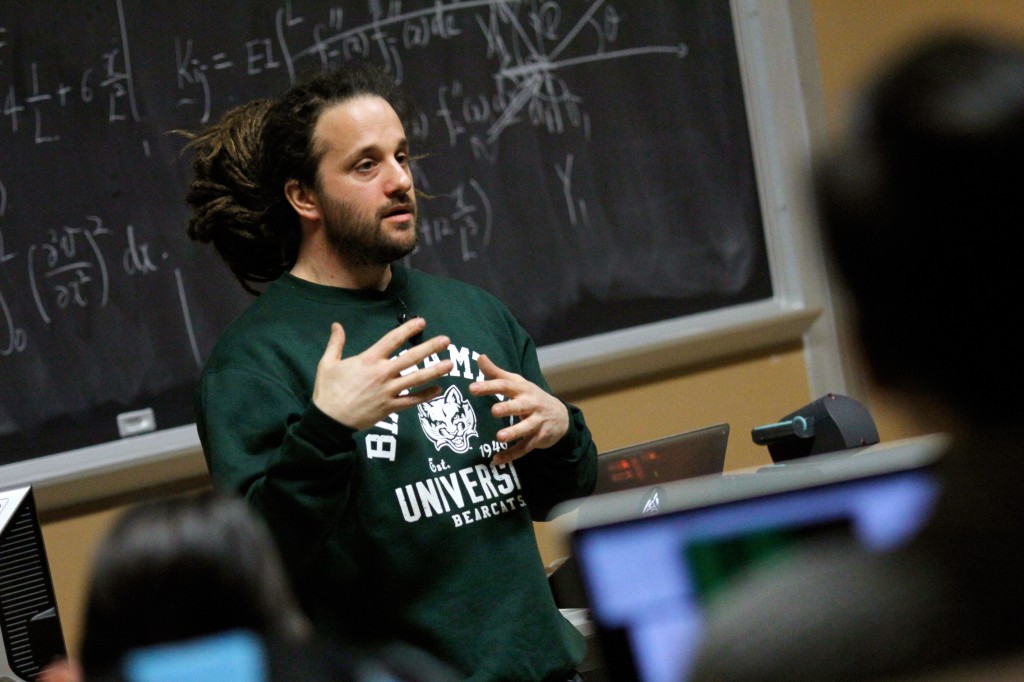
If a picture is worth a thousand words, then it’s safe to say that Steve Rosenfield’s are worth a thousand and then some.
Rosenfield’s “What I Be” project is based on a concept easier said than done: defeating your insecurities by opening up about them or, as he puts it, “creating security through insecurity.”
By the end of this week, more than 70 Binghamton students will have participated in creating this security by stepping in front of the camera.
Before getting photographed, each subject gets something personal written on them in sharpie. They then attach the caption, “I am not my ______,” placing their insecurity in the blank space.
In something of a culmination of the week’s photo sessions, Rosenfield held a talk on Thursday night in Lecture Hall 9 where he discussed how “What I Be” came to be.
Rosenfield began the project in 2010. He had more than 500 people leaving and entering his home.
Now, five years later, Rosenfield has shot thousands of subjects, and he notices the same insecurities coming up over and over again.
“There’s only so many of them,” he said in an interview. The high school students he’s shot tend to be more insecure about depression-related issues and feel pressure from their parents. College students, he says, gravitate toward insecurities related to gender and sexuality issues, and tend to put more pressure on themselves. They tend to think they have to look perfect to the outside world.
“Everyone on campus is appearing together — and perfect — when nobody’s together and perfect,” he said. “Nobody wants to look bad. Everyone wants to seem like they know what they’re doing next year, everyone wants to seem like they have it together — especially with mental health issues.”
Spots for Binghamton sessions filled up quickly. Additionally, Rosenfield said that Binghamton’s turnout showed something special. At other schools, the female-to-male ratio has been about 80 to 20. Here, it’s around half and half.
“Men, as a societal law, are not supposed to show their feelings,” Rosenfield said. “I’d like to say that here, guys are more open to talking about it.”
Rosenfield said he hopes that people will look past one aspect of a person, while simultaneously gaining more sensitivity to their situation, whatever that might be. If you own your insecurity, Rosenfield’s theory goes, people can’t turn it against you.
Those who went to the presentation were able to see this theory demonstrated firsthand. Rosenfield asked people to share their insecurities and, one by one, people stood up and spoke. Some of Steve’s subjects spoke about their experience, making it all the more personal.
“If you look through those 2,300 images, everyone is beautiful,” Rosenfield said. “Everyone looks beautiful in their picture. I don’t know if you noticed that. That’s what honesty does.”
At the talk, Rosenfield explained that when he was growing up, he judged people and felt that he had to outdo others. He said that while he had a lot of people in his life, his relationships were lacking because he withheld his emotions from the people around him.
After high school, Rosenfield went right into the workforce with a steady job at a computer company. And while he was able to support himself, he felt that there was something missing. Soon, he began rock climbing, a sport in which he found a community. He ended up embarking on a two-week climbing trip. While traveling, he decided that if he wanted to change how he was feeling, he had to do something different. Rosenfield decided to start opening up, first to a journal and then to others. He found that when he shared things with people, they reciprocated. Rosenfield went from feeling numb to feeling happy, created new bonds and formed new perspectives.
Rosenfield quit his job, sold his condo and traveled for the next four years, ending his trip by eventually moving to California. He said he had a bit of a rough start there, even with finding a place to live. He slept in the back of a van and worked in a rock climbing gym during the day. He soon moved into an apartment, and with his new home came a new hobby, as inspired by a friend on his rock climbing trip: photography. His first professional camera was a Canon Rebel XT.
What began as taking photos for fun soon turned into concert photography. He became close with Michael Franti and Spearhead, taking pictures of them, as well as other big names such as Macklemore, Norah Jones and The Chainsmokers.
While he enjoyed concert photography, Rosenfield wanted to do something that would make a difference, and in 2009, the “What I Be” project was born.
So what’s Rosenfield’s greatest insecurity? He hasn’t told anyone yet, but not because he doesn’t want to. It’s going to be published in his forthcoming book that collects some of his photos, on the “about the author” page.
The event was organized for the Binghamton University Marketing Association by Danielle Levin, a senior double-majoring in marketing and art, and Hadas Bernstein, a sophomore majoring in psychology.
“It really helped that he was so easy to speak to, and he would respond to every single email with every single question I’d ever ask,” Levin said. Bernstein said she plans to bring Rosenfield again next year.
For those who want to see the results of the project, the photos will be on display in the Fine Arts Building from March 30 until April 3, and those who were photographed can pick up their pictures on March 31 and April 1.


